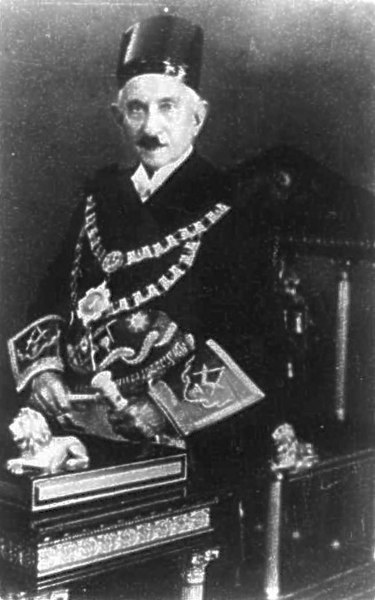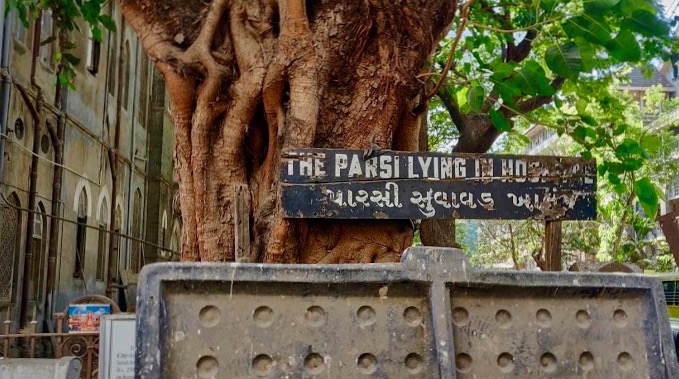This abandoned building partially hidden away by trees, sits quietly forgotten in a corner in the Fort area of Mumbai. Right opposite The Cathedral & John Connon School, the building with a fading sign-board tells you that this is the Parsi Lying-in hospital. What is its story?
Lying in hospital doesn’t sound like a pleasurable activity. But in the late 19th century, for a pregnant Parsi woman in Bombay (Mumbai), the Parsi Lying-in hospital (PLIH) was actually one of the best places to be.
The Parsis are Zoroastrians who arrived in the India between the 8th and 10th centuries from Persia in present day Iran. Many settled down in the region surrounding present day Mumbai. They are an extremely small community known to be highly educated and progressive. But their numbers are declining at an alarming rate. In 1941 there were more than a 100,000 Parsis. By 2011, there were just 58,000. There are many reasons for this decline – late marriages, postponing childbirth, marrying outside the community and choosing not to marry or have children at all.
But in the late 1800s, the Parsi population was declining for a very different and more serious reason. Young Parsi women were dying giving birth to children. Maternity death and infant mortality rates were extremely high. Giving birth in the good old days was a risky affair for most Indian women. Strange religious customs only added to the challenges that a pregnant woman faced. A Parsi woman was subject to same challenges as everyone else.
Back then, there were no maternity hospitals and most babies were born at home. During labour, a pregnant Parsi woman was confined to a dark stuffy room. Here, she would give birth aided by a medically untrained mid-wife, ill-equipped to handle any complications. For the mother, the ordeal didn’t end with giving birth. Soon after bringing a child into this world, the woman was seen as impure and had to remain in the same stuffy room for 40 days! After this time, she would be bathed in bull urine, a ritual that was said to purify her! Childbirth was a traumatic experience. It is no wonder that young mothers who gave birth in such unhygienic and their new-borns often died.
Thankfully, someone took notice and decided to do something about it. He was a Parsi obstetrician named Temulji Bhicaji Nariman. He, with a group of Parsi businessmen set up one of Bombay’s first maternity hospitals in 1895, known as the Parsi Lying-in hospital.

Why was it called a lying-in hospital? Well, a Parsi woman could lie or stay here for around a month after she gave birth, meaning she could spend those 40 days of impurity in clean comfort. The rooms were well-lit and airy and trained medical staff were always in attendance. The hospital was for all Parsi women. People paid according to their capacity and those who were too poor for even that, received treatment and care for free.
It isn’t surprising then, that the hospital which started as a 50-bed facility made its founder Temulji a beacon of hope for Parsi motherhood. But soon he would become even more. Just a year into the establishment of the hospital, the Bombay Plague Epidemic occurred killing thousands. Temulji jumped into the fray again. In 1914, he was knighted for his selfless service during the plague.
Sir Temulji Nariman’s hospital did well for several years. Other birthing centres opened up too. Maternity death and infant mortality rates went down but as you know, so did the Parsi community’s birth rate.
In the 1960s, the PLIH closed its doors. Parsi mothers had become few and the few, were increasingly choosing more modern institutions. For many years, the hospital was also caught in the midst of a legal tussle between the Bombay Parsi Panchayat and the Hospital Trust, both having different ideas about what to do with the building. Today, this charming heritage structure in Fort, Mumbai sits idle, awaiting its fate.

Thus, in 1791, Jonathan Duncan established the first Sanskrit College in modern India. The Sampurnanand Sanskrit Vishwavidyalaya in Varanasi is the oldest surviving Sanskrit college in India. It is now a University that is renowned for its library with a treasure trove of ancient Sanskrit manuscripts. And it owes its existence entirely to an Englishman!
But that wasn’t Duncan’s only achievement and not even his greatest. Perhaps his greatest contribution was the abolition female infanticide in Benares. Back then, the community of Rajkumars there, had a tradition of killing new-born female babies. Duncan summoned the community elders and convinced them that it was an unforgivable sin, especially according to Hindu scriptures. The Rajkumars signed a solemn agreement to give up this practice. Duncan realised that moral suasion was far more effective than legal enforcement in the cultural environment of India (Later, the British passed a penal law against infanticide during the leadership of Lord William Bentinck).
Lord Cornwallis was greatly impressed by Duncan’s achievements in Benares. When Cornwallis returned to England, he personally recommended to the Board of Directors that Duncan be made Governor of Bombay. Duncan served with distinction as Bombay’s Governor between 1795 to 1811. He had hoped to leave for England after retirement and even invested in a house in his homeland. But India, refused to let him go. He died in 1811, before he could retire, and was buried in St Thomas Church.
Jonathan Duncan’s memorial in Mumbai, stands as a quiet and beautiful witness to the possibility of harmonious and respectful existence, regardless of personal religious beliefs.
Join Storytrails in Mumbai on ‘The Bombay Story’ walking tour, and discover more stories hidden in plain sight in the Fort Area of Mumbai.
Archives
- January 2022
- December 2021
- November 2021
- August 2021
- March 2021
- February 2021
- January 2021
- December 2020
- November 2020
- October 2020
- September 2020
- August 2020
- April 2020
- March 2020
- February 2020
- January 2020
- November 2019
- October 2019
- September 2019
- August 2019
- July 2019
- June 2019
- August 2017
- February 2017
- January 2017
- October 2013
Featured Posts
- Tales that pots tell: Keeladi excavations AUGUST 18, 2021
- The Last Grand Nawab: Wallajah FEBRUARY 10, 2021
- How Tej Singh became Raja Desingu of Gingee FEBRUARY 5, 2021
- How Shahjahan seized the Mughal throne JANUARY 28, 2021
- Alai Darwaza – Qutub Minar Complex, Delhi NOVEMBER 21, 2020
- Marking History through British buildings NOVEMBER 17, 2020
- The last great queen of Travancore NOVEMBER 7, 2020
- Brahmi and the evolution of scripts OCTOBER 15, 2020
- The Cambodian King of Kanchipuram OCTOBER 14, 2020
- James Prinsep – the man who read the writing on the wall OCTOBER 10, 2020
- Mariamman – the Village Goddess who travelled SEPTEMBER 30, 2020
- Misnamed Monuments of Mamallapuram SEPTEMBER 28, 2020








